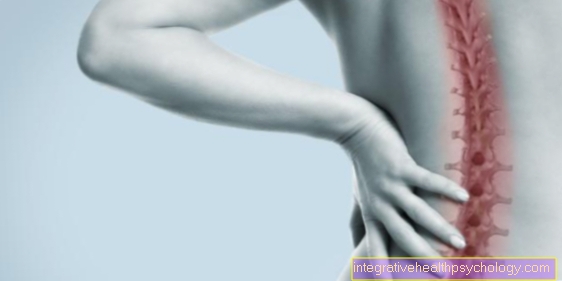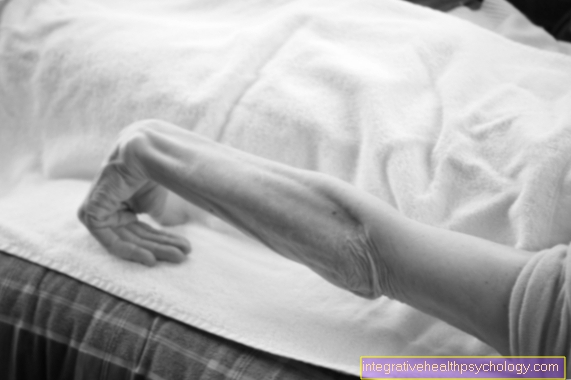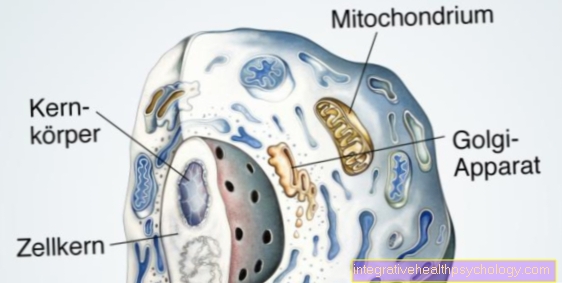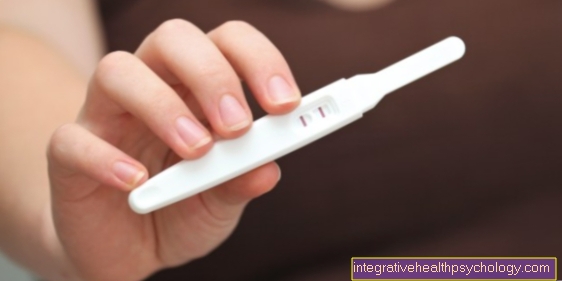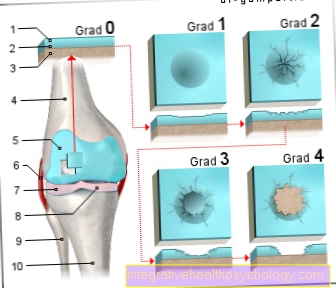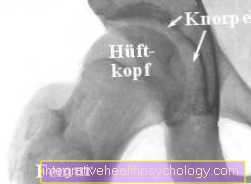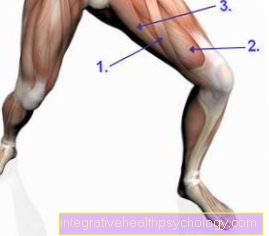Symptoms of an SIJ block
What are typical symptoms of an SI joint blockage?
Symptoms of SIJ blockade can be acute and very painful, or they can be gradual and become more severe.
The main symptom of the SI joint blockade is back pain, which is load-dependent and spreads to the entire hip area of the affected side.
Typically, the pain worsens with sedentary activities and is relieved somewhat by movement.
The pain is usually limited to the affected side and can radiate into the buttocks and the hollow of the knee.

In some cases, the pain can be limited to the groin or the back of the knee. In these cases, diagnosis is often somewhat more difficult because the typical clinical picture is missing.
It is said that the pain of an SI joint blockage can be as severe as a herniated disc in the lumbar spine. In contrast to this, however, there are no nerve failures. This is an important symptom in making a correct diagnosis and should always be checked by the doctor. The muscles' own reflexes are therefore intact and even after a long period there are no circulatory disorders or signs of muscle breakdown on the affected side. In addition, the pain with an ISG block does not radiate, but is limited to the affected hip.
Read more on the topic: SIJ pain - what can be done?
Symptoms in the groin
The SI joint blockade is primarily located below the lumbar vertebra area. Most of the pain is in the lower back, but it can spread to surrounding areas. One speaks of a pseudoradicular pain spread.
The pain can radiate along certain lines to anatomically adjacent areas. However, the origin of the pain is not from the irritation of a nerve root. Therefore, the course and spread of the pain in the SI joint blockade are difficult to predict. However, areas that the pain often spreads to include the buttocks, groin, front and back thighs, and in some cases the knee. Isolated pain symptoms only in the knee or only in the groin can rarely occur, which makes the diagnosis more difficult.
The pain in the groin is often accompanied by symphysis pain. The symphysis connects the hip bones in the middle above the bladder. The reason for the pain is also the strain on the ligamentous apparatus. The symphysis can be painful due to increased tension and strong muscle tension in the SIJ. Likewise, a symphysis tension can also trigger the SI joint blockade through reflex-like muscle tension.
Pregnancy is a common cause of these symptom constellations.
You might also be interested in: ISG blocking
Appointment with a back specialist?

I would be happy to advise you!
Who am I?
My name is dr. Nicolas Gumpert. I am a specialist in orthopedics and the founder of .
Various television programs and print media report regularly about my work. On HR television you can see me every 6 weeks live on "Hallo Hessen".
But now enough is indicated ;-)
The spine is difficult to treat. On the one hand it is exposed to high mechanical loads, on the other hand it has great mobility.
The treatment of the spine (e.g. herniated disc, facet syndrome, foramen stenosis, etc.) therefore requires a lot of experience.
I focus on a wide variety of diseases of the spine.
The aim of any treatment is treatment without surgery.
Which therapy achieves the best results in the long term can only be determined after looking at all of the information (Examination, X-ray, ultrasound, MRI, etc.) be assessed.
You can find me in:
- Lumedis - your orthopedic surgeon
Kaiserstrasse 14
60311 Frankfurt am Main
Directly to the online appointment arrangement
Unfortunately, it is currently only possible to make an appointment with private health insurers. I hope for your understanding!
Further information about myself can be found at Dr. Nicolas Gumpert
Tingling in the buttocks
The buttocks are often also affected by pain in the ISG blockade. As a rule, the ISG blockade is a pseudoradicular spread in which no nerves are affected.
The pain can spread down the leg along tendons. A tingling sensation that runs along certain lines is atypical for the SI joint blockade.
Tingling is often associated with numbness, slight pain and, under certain circumstances, paralysis.
The typical ant-walking or tingling sensation suggests that nerves are involved. The strong sciatic nerve runs in the buttocks. If this nerve is involved, it must be checked whether there is a herniated disc or a crushing of the nerves in the lower spine.
Tingling in the leg
Pain spreading into the leg is also not uncommon with SIJ blockade. It takes place via tendons that extend from the hips into the legs. The knee is also a common place of pain with an SI joint.
It is very important for diagnosis what type of pain is present. As a rule, a tingling sensation, which may be associated with numbness and loss of sensitivity, suggests that the pain is spreading through irritation of nerves.
In the case of SI joint blockade, however, nerve irritation does not normally occur, which is why other diagnoses such as a herniated disc or sciatica irritation must also be considered.
Pain as the main symptom
Pain is the main symptom of the SI joint blockade. The main pain lies in the affected joint itself, i.e. at the lowest point of the spine, the sacral vertebrae. Most movements of the hips and lower back also strain the joint, which is why severe pain in the joint is to be expected in the event of a blockage.
What might also interest you: Sacrum pain
Movements such as standing up, lying down and sitting for a long time are very painful. Since the blockage is mainly muscular, the pain increases after prolonged inactivity, for example after long periods of sitting. Exercise and warmth can relieve the pain. Certain sitting and lying positions make the pain more bearable.
In addition to back pain, SIJ blockade can cause pain in the buttocks, groin, legs and knees.
Read more on the topic: Therapy of an ISG blockade
Illustrations on the subject of ISG blockade

ISG - blockade - conduction symptoms
- Sacrum-iliac joint
(Sacroiliac joint,
abbreviated ISG)
Articulatio sacroiliaca - Front Sacrum-iliac ligament
Lig. Sacroiliacum anterius - Iliac bone - Os ilium
- Sacrum - Sacrum
- Lumbar and sacrum kink -
Promontory - Fifth lumbar vertebra -
Vertebra lumbalis V - First lumbar vertebra -
Vertebra lumbalis I - Thoracolumbar junction
- Twelfth thoracic vertebra -
Vertebra thoracica XII - Hip joint - Articulatio coxae
Pain radiation areas:
A - lumbar spine (lumbar spine)
B - buttock region - Gluteal region
C - Groin - Inguinal region
D - front and back leg
E - knee
You can find an overview of all Dr-Gumpert images at: medical illustrations

- Sacrum-iliac joint
(Sacroiliac joint, abbreviated ISG)
Articulatio sacroiliaca - Iliac bone -
Os ilium - Sacrum -
Sacrum - Anterior sacrum-iliac bone
-Tape -
Lig. Sacroiliacum anterius - Fifth lumbar vertebra -
Vertebra lumbalis V - Fourth lumbar vertebra -
Vertebra lumbalis IV - Tailbone -
Os coccyxis - Pubic bone -
Pubis - Femoral shaft -
Corpus femoris - Lumbar cruciate ligament kink -
Promontory
You can find an overview of all Dr-Gumpert images at: medical illustrations



